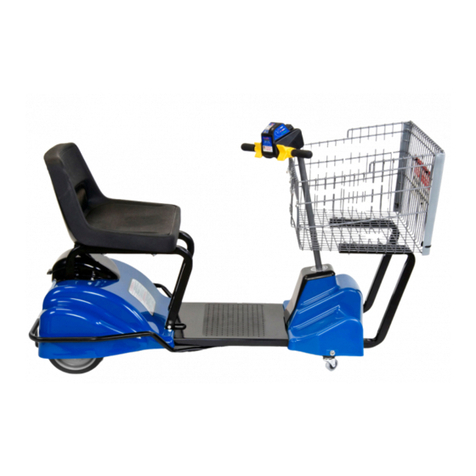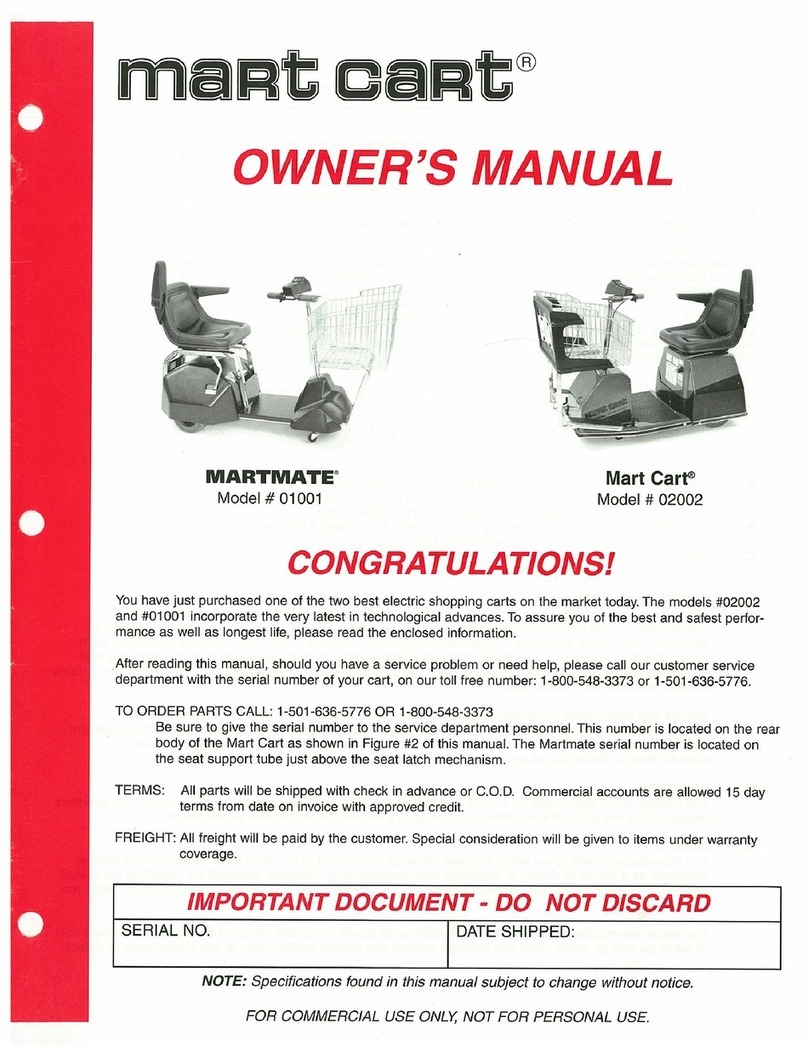
m.
FREIGHT DAMAGE:
CHECK: 1. The shipping carton for any visible damage. Report the damage to the freight carrier
immediately. File a claim with
the
carrier
if
actual damage to your cart has occurred.
2. Contents
of
the carton. The contents should agree with the information listed on the
packing list. Report any shortage to the carrier and the factory immediately.
IV
. WARRANTY REGISTRATION: I
1. Complete & return the
WARRANTY
REGISTRATION CARD. Noting the serial numberlocated near
the charging cord.
BEFORE OPERATING, READ ALL INSTRUCTIONS THOROUGHLY.
v. IPREVENTATIVE MAINTENANCE: I
VI
.
1.
Ifrequired, checktire pressure every6 months.Airtiresto30PSI
or
as printedon thetire sidewalls.
Most carts after November, 1990 are equipped with foam-filled tires, in which case only an
occa
-
sional inspection
of
tread wear is necessary.
2. Check cord reel daily for proper operation. Cord should retract fully into rear housing with only
the plug showing. Replace
if
faulty.
3. Check dailythe condition
of
the
power supply cord. Replace with new cord reel
if
worn
or
frayed.
4. Check dailythe operation
of
the
cart -all functions: key switch, forward-reverse switch, battery
condition meter, seat switch, safe-t-stop, chairlock &swivel, throttle, foot brake, etc. Repair
if
faulty.
5. Check daily the anti-tip castors (dwg. #23, fig.
1)
to be sure they are adjusted properly and are
in good condition.
6. Clean cart daily. Use "Appliance Magic" fiberglass & plastic cleaner for high luster.
NOTE: For
the
best preventative maintenance plan, and best CUSTOMER SERVICE, assign one
employee the daily task
of
cleaning and inspecting the cart(s). This way you will know who
is responsible for the cart(s) and there should be
no
excuse for customer dissatisfaction.
BATTERY CHARGING: I
1. Install a Ground-Fault Circuit Interrupter (GFCI) in store's electrical outlet wherever Mart Cart is
to be charged. This is to protect against any possible shock hazard. Installation
of
the GFCI must
be done by a licensed electrician.
2.
AC
voltageof the powersource required is 120
VAC
currentdraw
is
1.6 amps A.C. (output of charger
is 14.5 volts D.
C.
, 6 amps.)
3. Charge battery nightly after dailyusage. When battery is fully-charged, the charger will
ma
intain
a "trickle" charge to keep battery at its peak
or
shut
off
automatically depending
on
charger type.
We
recommend chargingtime not to exceed
10
hoursto achieve the maximum battery and charger
life.
To
accomplish thi
s,
a
110
volt
10
hour timer is recommended.
WARNING- 4. Do notcharge continuously, such as
dur
ing theday & night, as it's not necessaryand will reduce
the battery life. Daily excessive charging more than the
10
hours recommended could result in
severe damagetothe batteryand possiblythe charger. Always keepbatterycovered whilecharging.
5.
One complete charge
(14
hours
if
battery is completely without charge) will allow
up
to 3 days
of
normal grocery store operation.
6.
To
determine if chargerisworking
or
battery istaking a charge;
1)
Plugcord in to live wall socket, 2)
Turn key switch to "
ON"
position, 3) Place direction switch (FWD/REV switch) in "OFF" posi-
tion, 4) Rotate throttle grip to full "on" position. Needle should move from left to far-right side
of
battery condition meter. If the needle doesn't move, see "Trouble Shooting" Chart on page 5.
7. Maintenance
of
battery: none required as battery is a gel-eel design and requires
no
water.
Under normal circumstances, the Mart Cart battery should last 1½ to 3 years,
or
longe
r,
if
the above
recommendations are followed. Replace with
an
original gel-eel battery. Mart Cart™is not respon-
sible for any adverse effects caused
by
a replacement lead-acid battery.
-4
-






























